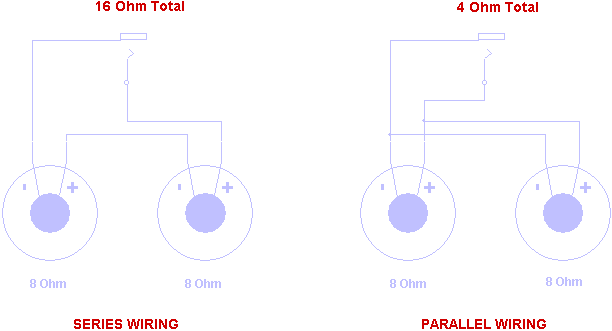I'm wanting to know how hard it would be to rewire a combo amp(hot rod DeVille 212) it has two 8 ohm speakers wired in parallel for 4 ohm output. If I get this amp in the future as planned I want to be able to rewire the two 8 ohm speakers in series for an output of 16 ohms. What does this entail? Any help here would be greatly appreciated.
Announcement
Collapse
No announcement yet.
Rewiring 2x12 cab to series
Collapse
X
-
Easy. Run a lead to the positive of one speaker and the negative of the other. Then run a wire directly between the speakers on the unused terminals.Originally posted by Mikelamury View PostI'm wanting to know how hard it would be to rewire a combo amp(hot rod DeVille 212) it has two 8 ohm speakers wired in parallel for 4 ohm output. If I get this amp in the future as planned I want to be able to rewire the two 8 ohm speakers in series for an output of 16 ohms. What does this entail? Any help here would be greatly appreciated.
Sent from my SM-A115A using Tapatalk
- Likes 2
-
Coupla things to bear in mind:
Ohms are a unit of impedance, not a measure of output.
An amp's speaker output might be labeled in Ohms, to tell you what load it's looking for.
Speaker cabs often are labeled it Ohms too, to tell you the load they put on an amp driving them.
Second, running an amp that wants a 4 Ohm load into a 16Ω one instead might not be ideal.
In general, a lower load than spec'd is more likely to cause problems, but occasionally a higher load can, too.
How loud you play is an important factor here. At bedroom volumes, trouble is unlikely in either case.
But if the amp is being pushed hard and for long periods, improper loading is more likely to cause trouble.
The transformers in many amps - especially those made overseas, like the modern Fenders - aren't typically very robust.
You might check with somebody who knows this model pretty well before pushing it hard with a 16Ω load.
Could be perfectly okay. But if it were mine, I'd want to make sure.
I probably wouldn't run my blackface Bandmaster into a 16 Ohm load. Not at stage volume, anyway.
.
"You should know better by now than to introduce science into a discussion of voodoo."
.
Comment
-
I appreciate the suggestion, I'm only using it for house levels of volume, no stage volume but I will check into that before rewiringOriginally posted by eclecticsynergy View PostCoupla things to bear in mind:
Ohms are a unit of impedance, not a measure of output.
An amp's speaker output might be labeled in Ohms, to tell you what load it's looking for.
Speaker cabs often are labeled it Ohms too, to tell you the load they put on an amp driving them.
Second, running an amp that wants a 4 Ohm load into a 16Ω one instead might not be ideal.
In general, a lower load than spec'd is more likely to cause problems, but occasionally a higher load can, too.
How loud you play is an important factor here. At bedroom volumes, trouble is unlikely in either case.
But if the amp is being pushed hard and for long periods, improper loading is more likely to cause trouble.
The transformers in many amps - especially those made overseas, like the modern Fenders - aren't typically very robust.
You might check with somebody who knows this model pretty well before pushing it hard with a 16Ω load.
Could be perfectly okay. But if it were mine, I'd want to make sure.
I probably wouldn't run my blackface Bandmaster into a 16 Ohm load. Not at stage volume, anyway.It's funny how some stories became historic,
especially when the authors clearly wrote them to be metaphoric,
But people will believe anything when it's written in stone or ancient scroll...-Fat Mike
- Likes 1
Comment
-
I would run the amp at 8 ohms. You always want the ohm rating of the cab to be higher than the amp.Originally posted by JB6464 View PostI picked up a quad of EVM12L Classic speakers that are 8 ohms each.
Wired in series parallel in my 4X12 it reads 10.2 on the multimeter at the jack.
Should i run it at 16ohm or 8 ohms off the head of my Soldano?
- Likes 2
Comment
-
No problem. Use this rule of thumb when thinking about amps, speakers, and ohms. If you were pouring water from one glass to another the glass receiving the water (cab) would have to be the same size or bigger than the glass pouring the water (amp). For example, if you pour 4 oz (ohms) into an 8 oz (ohm) glass you are fine. If you pour 16 oz (ohm) into an 8 oz (ohm) glass it will spill over and that is when you run into problems and possibly damage your amp. The cab should be equal or bigger in ohms to the amp.Originally posted by JB6464 View Post
Thank You!
- Likes 2
Comment


 .
.
Comment